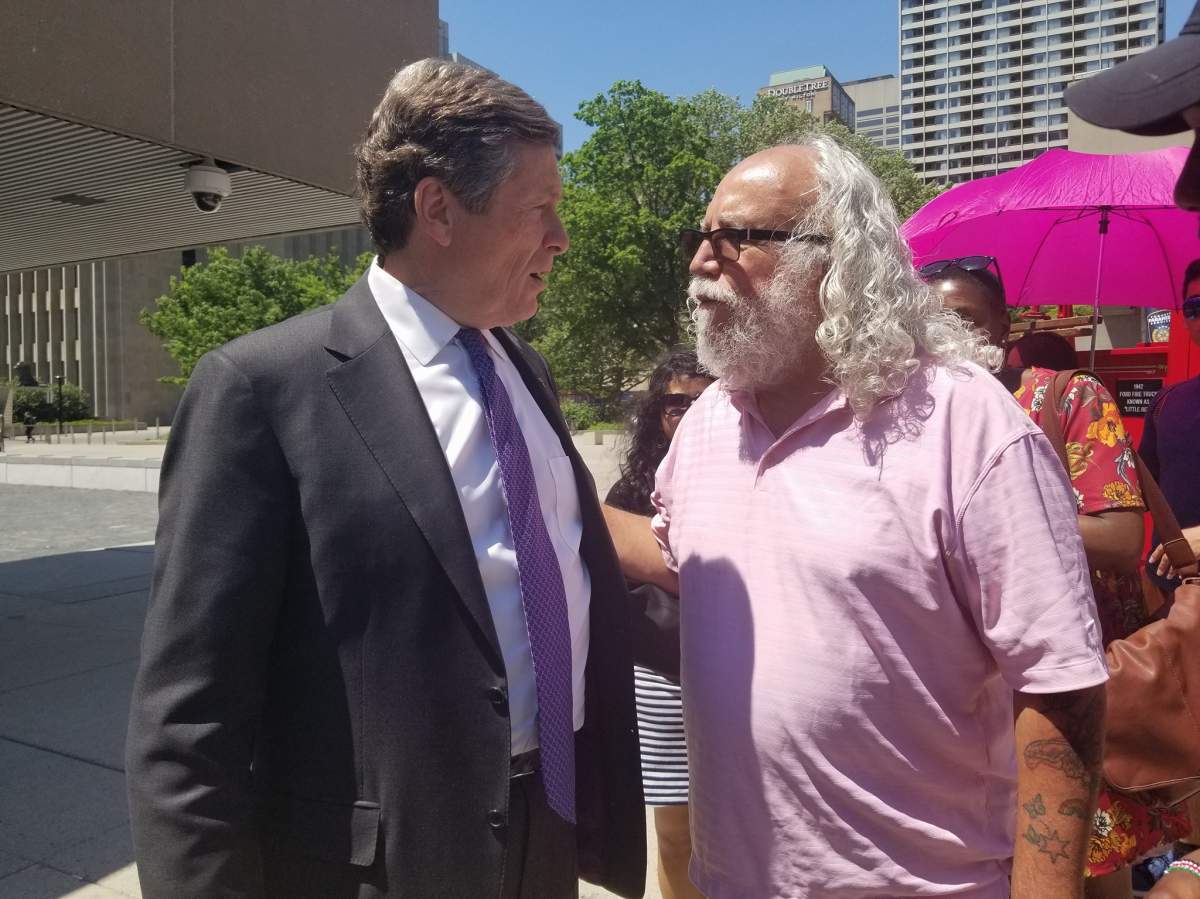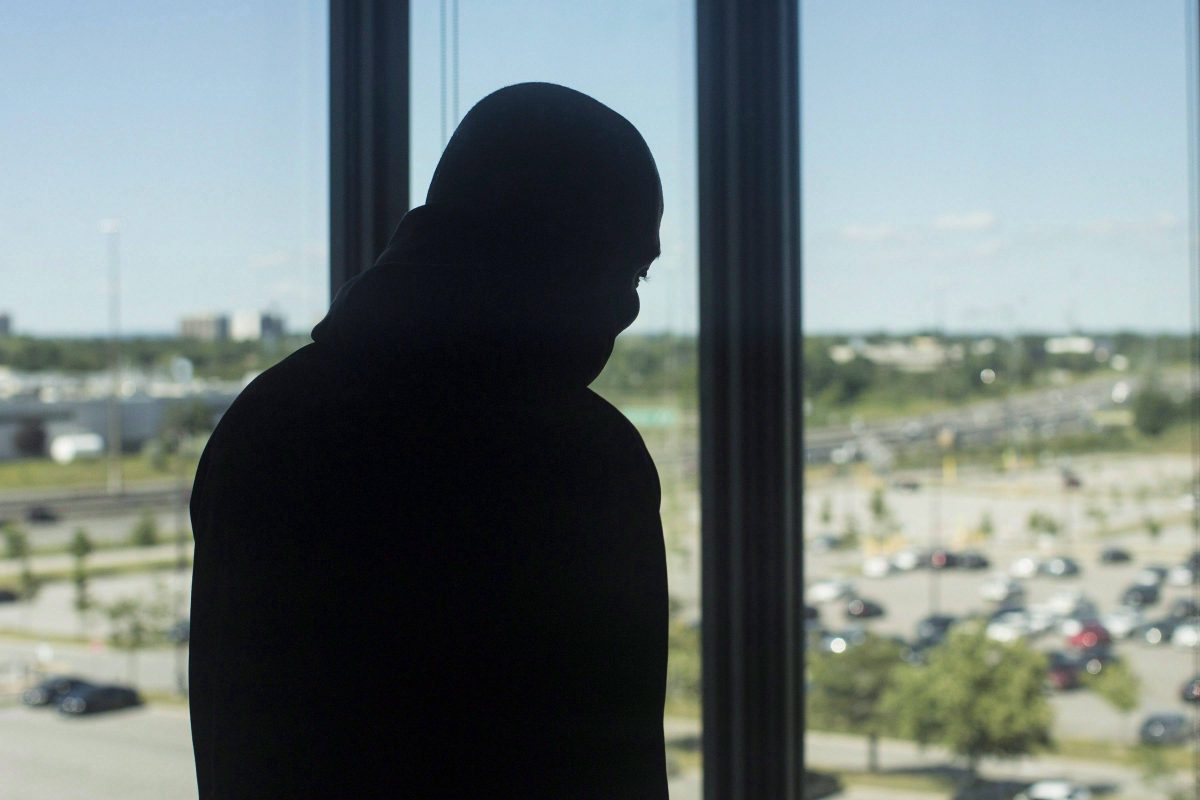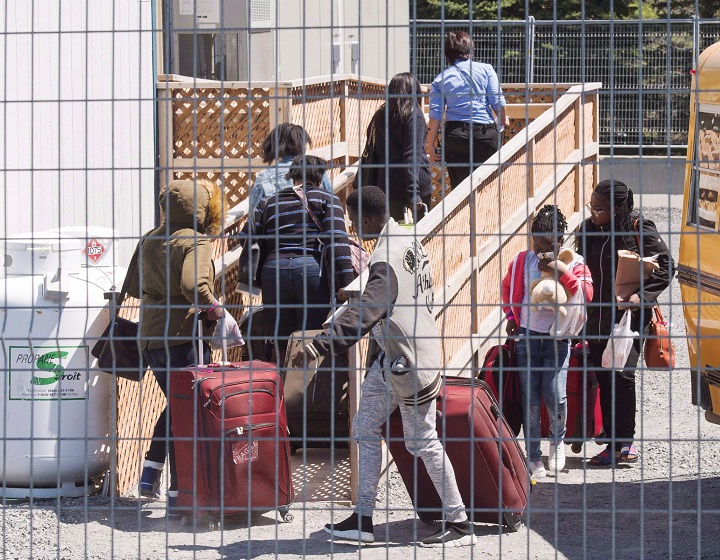Just off the Highway 401 in Burlington, Ont., Lex Miller and his partner Ralanda Mitchell live on the third floor of a Holiday Inn in an industrial part of the city, each day waking up with a sense of anxiety.

It’s their fourth home in less than five months since coming to Canada from the Bahamas, where they escaped a life marked by persecution and intimidation from landlords, co-workers and even family members.
READ MORE: Is Canada facing an asylum seeker ‘crisis?’
They are among the thousands of refugees bouncing around between temporary living situations which have become a hallmark of Canada’s response to the influx of refugees. And it’s creating a life filled with uncertainty.
“It seems more like a chaotic, topsy-turvy system,” Miller told Global News. “It’s like you already started to set up your life here and all of a sudden, you’re uprooted so you have to get accustomed to a whole new city, a whole new way of doing things.”
Miller and Ralanda, a transgender woman, met in 2016 in Freeport and he quickly proposed to her, but they were not allowed to marry as same-sex marriage is illegal in the Bahamas.
The country may have a reputation as a tropical destination, but it’s also known for homophobic violence and discrimination, Miller says. The Grand Bahama Human Rights Association has called for hate crime laws following increased attacks on LGBTQ members.
“You have situations where you can be walking in the street in your own community and people can taunt you, throw rocks at you, beat you up,” Miller said. “As a gay person that’s a Bahamian … it’s not as sweet and nice as it appears.”

The couple decided to leave the country for Canada after their home was destroyed by Hurricane Matthew and following a series of violent murders of gay men and LGBTQ activists in the country, many of which were never solved.
“A friend of mine, he got murdered and the judge ruled that his murderer was defending his manhood and he was not prosecuted for it. He was not convicted,” Miller said, describing what is known as the gay panic defence.
They managed to leave the Bahamas, but they are now among the wave of asylum seekers caught in a battle between municipal, provincial and federal governments over housing, medical and social costs.
In Toronto, Miller along with some 600 refugee claimants, including families and children, have been moved around from the city’s shelter systems to dorms at Humber and Centennial College and now to federally-funded hotels in Mississauga, Markham, Etobicoke and other cities in the GTA.
Miller and Ralanda arrived in Canada last May at Pearson International Airport before heading to Toronto’s Church-Wellesley village — the heart of the city’s LGBTQ community.
“When we walked into the village, even though it was our first time, I felt a sense of peace, a sense of pride, a sense of acceptance,” Miller said.
But while they found acceptance, the couple was again faced with homophobia. At a shelter in Scarborough, they were accosted by several men yelling the word “faggot” and in one case, they were propositioned for sex, Miller said. They eventually moved to the George Street respite facility.
READ MORE: Asylum seekers sit in state of limbo as they wait for refugee claims to be heard in Canada
One shelter worker advised them not to disclose their sexual orientation, according to Miller.
“It was like, ‘Wait a minute, I left the Bahamas to be myself. And the first thing I got to do is go right back to what I had to do,’” he said.
Toronto spokesperson Natasha Hinds-Fitzsimmons wouldn’t comment on the incident but said the city has Shelter Standards in place “to ensure access to services and safety for members of all vulnerable communities.”
“The City is always looking for ways to improve service and meet unfulfilled needs of service users,” she said.
WATCH: Debate around asylum seekers
Adrienne Smith, an immigration lawyer representing the couple, said there has been a consistent underfunding of the city’s refugee and shelter system for years that is now being exposed.

Get breaking National news
“They’re trying to settle, they’re trying to get jobs, they’re trying to regularize themselves, they’re trying to get their kids into school,” she said. “It’s extremely difficult when you don’t have that baseline of consistent long-term housing. It makes it very, very hard for our clients.”
She adds that given the increasing number of LGBTQ refugee applications, the city needs to consider a homeless shelter specifically for LGBTQ adults.
“What I’ve heard from so many of my clients is that they actually ended up having to go back into the closet when they’re in the refugee shelter system,” she said. “At the end of the day, Canada does have a responsibility to make sure that people feel safe when they’re here.”
A new normal
By the end of 2017, 68.5-million people around the world were forcibly displaced, of which a record 25.4 million are refugees, according to data by the United Nations refugee agency.
Advocates working with asylum seekers say Canadian officials need to be prepared that the more-than-50,000 who arrived last year, up from more-than-20,000 in 2016, may be a new normal.
At the centre of this is the more-than-26,000 migrants who have crossed the border irregularly since May of last year, a number that is higher than the 25,000 Syrian refugees that arrived in Canada in 2015 and 2016. So far in 2018, more than 30,000 have entered Canada seeking asylum, according to government figures.
And while those numbers may seem high, looking back at previous years, Canada has seen much higher spikes of refugee claimants: 36,856 in 2008, 33,426 in 2002 and 44,640 in 2001.
Francisco Rico-Martinez, co-director of the FCJ Refugee Centre in Toronto, said the housing uncertainty coupled with the lack of information from officials is detrimental to the mental health of refugees.
“In a hotel, you never feel at home, you’re already ruined depending on many things. So you feel that you haven’t get there yet. It’s very traumatic, particularly for children.
“It’s a cultural shock. They have never eaten the food at a hotel. They are dying for eating traditional food that they can’t cook.”
Many of the refugee centres’ clients were housed in dorms before moving to hotels outside of Toronto, away from immigration lawyers and their support networks.
They don’t yet know what will happen after Sept. 30.
“That was the question. Do you know what is going to happen to us? Do you know if they’re going to put us on the street? But you know, they’re going to move us somewhere else?” he said.
READ MORE: Asylum seeker claims increase in July, down year-over-year
A long-promised triage system aimed at redirecting irregular border crossers from crowded shelters in Montreal and Toronto will not be in place until the end of September, according to the federal government.
Ottawa says it’s working with individual municipalities across Ontario and must identify available housing capacity before it can roll out its triage program.
The border ‘crisis’
For two years, asylum seekers have been caught up in a fiery political debate. The Conservatives have continued to blast Justin Trudeau’s Liberal government over the flow of asylum seekers at unofficial border crossings from the U.S, calling it a “crisis.”
Federal Immigration Minister Ahmed Hussen and the new PC Ontario government have had particularly blistering exchanges after Premier Doug Ford demanded that Trudeau’s Liberals clean up the “mess” of “illegal border crossers.”
WATCH: LeBlanc takes over federal-provincial task force

Hussen called Ford’s comments on the issue “dangerous.”
“It’s fear-mongering and it’s not Canadian,” Hussen said in July. “Ontario sadly has chosen the language of fear. They’ve chosen to intentionally use language that could potentially criminalize asylum seekers in the minds of Canadians.”
READ MORE: ‘Illegal’ or ‘irregular’? Debate about asylum-seekers needs to stop, experts warn
The issue sparked the creation of a federal task force to manage the government’s response to the spike in irregular crossings. The head of the task force on irregular migration, Transport Minister Marc Garneau, was recently replaced by Dominic LeBlanc.
And Hussen is no longer on the government task force, a move cheered by his Ontario counterpart, Lisa MacLeod, Ontario’s minister of children, community and social services.
MacLeod has demanded $200 million in funding from Ottawa to reimburse it for costs incurred so far assisting border-crossers who have come to Ontario, including $90 million in social assistance; $12 million in emergency shelter costs for the city of Ottawa and another $74 million for shelter costs in Toronto; and $20 million in education costs.
An uncertain future
Meanwhile, asylum seekers including Miller and Ralanda continue to wait with uncertainty about if, or where, they will be moved.
Their lawyer called Ford’s rhetoric around “illegal border crossers” fearmongering and dehumanizing.
“It’s politicking and it’s using refugees as a pawn in a political fight,” Smith said. “The city, the province and the federal government all benefit from actually having refugees here, especially for the city of Toronto.
“I think it’s very disappointing that the province is using this group that contributes so much to the province and kind of denigrating them as a group that’s unwanted.”
WATCH: Toronto faces refugee housing ‘crisis’

Francisco says Canada deserves a failing grade when it comes to helping resettle the recent influx of refugees across the country, but said there is hope.
“The city of Toronto and the federal government, they are in the emergency mode. In the emergency mode, they do very short-term things,” he said. “They’re putting people into dorms, and now the people from the dorms are going to be moved to hotels.
“It’s so expensive to do all of this.”
WATCH: Canada spent $166 million dealing with asylum seekers

Toronto will spend an estimated $64 million on temporary housing for refugees this year alone, while Ottawa has pledged $11 million to help the situation. Canada has spent over $270 million on irregular border crossers over the last year and a half, according to the parliamentary budget office.
Francisco said his organization contacted the city in the fall, warning about the need to prepare for the number of refugees heading to Toronto. His organization, among others, asked for a centralized intake space, increased housing workers, more emergency beds and the building of transitional housing.
“It is not an emergency. We can handle it.”
READ MORE: Ottawa’s plan to help overwhelmed cities deal with asylum seekers still weeks away
Toronto spokesperson Natasha Hinds-Fitzsimmons, said the city continues to work closely with resettlement agencies as key partners in the City’s response to this issue.
“Refugee claimants are coming into the Toronto system at a rate of about 15 to 20 people a day,” she said in an email. “Toronto’s shelter system continues to have motel/hotel beds for families, with four refugee programs providing more than 2,600 beds, mainly for refugee claimant families.”
For Miller, he and Ralanda are hoping to get married and build a life together in Toronto where they are currently looking for an apartment. They currently do volunteer work in the Village and hope to pursue new careers in marketing or public relations work.
“Give us an opportunity to actually get stabilized and become productive residents and citizens of Ontario,” he said. “Please, if he could build a shelter that is conducive for LGBT refugees, adult couples and juniors because it’s one thing being a refugee, it’s another thing being an LGBT refugee.”







-ONLINE_848x480_1291960387908.jpg?w=1200&quality=70&strip=all)












Comments